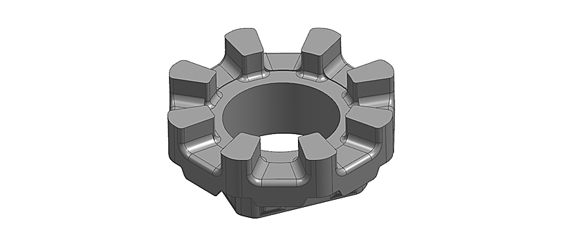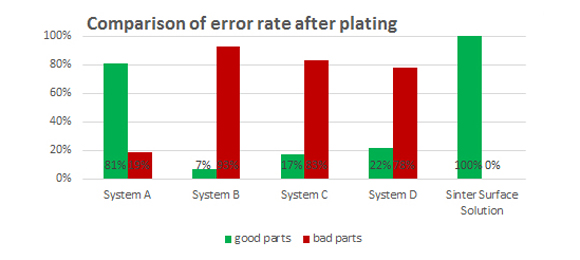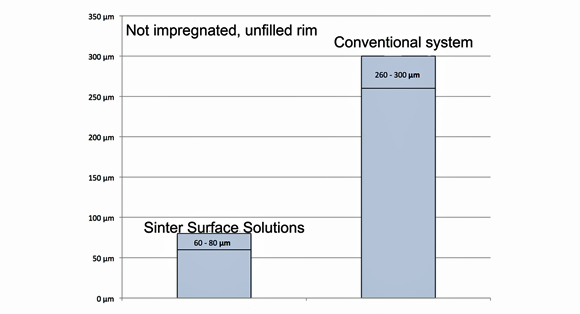Holzapfel’s Sinter Surface Solutions enables zinc-nickel plating of PM automotive components
May 24, 2018

The locking disc, designed by GKN Sinter Metals, is a component for a passive pedestrian protection mechanism (Courtesy Holzapfel Metallveredelung GmbH)
Holzapfel Metallveredelung GmbH, Sinn, Germany, reports that its Sinter Surface Solutions technology has successfully enabled the impregnation and subsequent zinc-nickel plating of a safety-critical Powder Metallurgy automotive component. The component, a locking disc for a passive pedestrian protection mechanism, is produced by GKN Sinter Metals in Bonn, Germany, on behalf of automotive supplier Edscha, Bavaria, Germany.
In case of a head-on or similar collision with a pedestrian, the locking disc actuates a mechanism that causes the bonnet of the vehicle to spring open just below the windscreen. The bonnet thus cushions the impact and reduces the risk of the pedestrian’s head, for example, colliding with hard parts of the engine. It is thus extremely important that this component remains fully functional throughout the life-cycle of the vehicle.
The intricate geometry of the part meant that it would be very difficult or impossible to produce using cutting or milling techniques, so Powder Metallurgy was selected as the production technology. However, heat and corrosion resistance plays a key role in the component’s lifespan, particularly in the exposed engine compartment area – and while zinc-nickel platings are commonly used to protect components from corrosion in engine compartments, it has traditionally been difficult to electroplate PM components due their tendency to absorb the liquids used during the plating process and gradually ‘bleed out’, releasing them over their lifespan.
With electroplating processes such as zinc or zinc alloy, this phenomenon frequently leads to salts being deposited on the surface. In most cases, these salts also attack the plating, causing localised surface corrosion. Other plating problems also occur more frequently when components manufactured using Powder Metallurgy are plated with zinc-nickel. For example, in some cases only a nickel layer is deposited, or the component is not plated at all. The technological advantages of using sintered materials for making components are thus sometimes offset by disadvantages in surface finishing.
‘Bleed-out’ in PM parts is caused by the porous structure of the sintered metals. As a result, in order to counteract this process, the porous structure can be closed using a synthetic resin or similar material prior to surface treatment. This process is known as impregnation and has its origins in the casting industry. However, GKN’s success in impregnating sintered PM components prior to plating has been quite limited and inconsistent, stated Holzapfel.
Tests conducted by the Holzapfel Group showed that when using conventional methods for impregnating sintered metals, around 3-5% of pores were not filled, most of which were located on the rim of the component. This unfilled rim was approximately 200-400 μm thick and explained the poor results achieved when applying surface finishes to conventionally impregnated sintered materials, particularly when alkaline alloying techniques such as zinc-iron or zinc-nickel were used.

Comparison of the unfilled rim on a sintered product treated with Sinter Surface Solutions and on a component impregnated and coated using conventional methods (Courtesy Holzapfel Metallveredelung GmbH)
Holzapfel’s Sinter Surface Solution was selected to address these issues, using a special-purpose impregnation and a plating adapted to suit it. The impregnation process was optimised by adapting both the process itself and the resins used in order to meet requirements compatible with the plating process. A key advantage of the Sinter Surface Solutions process is said to be the adaptability of the hardening process, which ensures that the pores are reliably impregnated to cover the entire surface of the component.
Adapting the hardening process to the requirements of the best possible surface makes it possible to ensure reliable and reproducible impregnation, filling almost 100% of pores right up to the edge, without leaving resin residues on the surface of the part. According to Holzapfel, this is achieved by a hardening process in which the resin inserted into the pores begins to harden from the interface surface at the entrance of the pores towards the inside. The droplet formed closes the pores on the outside and prevents the resin from bleeding out, similar to a cork in a bottle.
Using Sinter Surface Solutions, the company stated that the width of the non-impregnated rim was reduced by 70-80% and is now approximately 60-80 μm on average. The entire filling volume of the pores was increased by up to 99.8%. At the same time, the plating method was changed to a special zinc-nickel process adapted to meet the specifications of the locking disc.

Comparative assessment of five impregnation systems, conducted after plating, based on plating imperfections. All components impregnated and plated using production equipment under series conditions (Courtesy Holzapfel Metallveredelung GmbH)
The combination proved to be highly successful, with both the impregnation and the plating being specially designed for the component and guaranteeing a zinc-nickel plating with flawless layer growth. The benefit for the customer was clear, the company reported, as the impregnation and plating made possible by the use of Sinter Surface Solutions enabled the component to be manufactured using the selected base material and the required surface.















